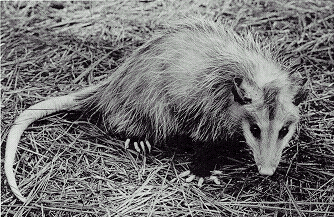 You could look a pretty long time
You could look a pretty long time and not find anyone as sympathetic to over-population problems --both canine and human -- as I am. I have spayed or neutered all my own dogs, and I have never had a litter of pups despite over 40 years with dogs.
I raise money for canine rescue and have rescued dogs directly from the street.
I suspect not many people in the world can say they have written
a book that mentions the importance of Thomas Malthus in the development of the dog, and even fewer that have also written a piece entitled "
Thank You for Not Breeding."
I take a back seat to almost no one when it come to population control. I have a Masters Degree in Demography, and at the age of 25 I walked into a urologist to get a vasectomy. The next week I began the process of adopting two children (now lovely young adults) from overseas. I imagine I am one of the very few working terrier enthusiasts in the world that can give a talk about all
23 methods of human fertility control.
Nor am I a big supporter of dog breeders. I do not value ribbons and paper pedigrees. My general recommendation to people looking for a pet dog is to go to rescue and/or or the local shelter. I do
not believe that a "pure bred" Kennel Club dog is a better pet than a mongrel, any more than I think the Royal Family is a good place to find an athlete or a brain surgeon.
With such such deep concerns about over-population and the welfare of dogs, and a rather pronounced skepticism about the merits of paper pedigrees and selective breeding, you would think I would be the kind of person that supports mandatory spay-neuter programs as a way of reducing the number of dogs that end up in kill shelters.
But, as a general rule, I do not.I am against broad mandatory spay-neuter proposals not only for
practical reasons (they generally do not work as intended), but also for philosophical reasons.
First the philosophical reasons. I am pro-choice. Or, to put it another way, I am generally
against authoritarianism, and I am
for rational discourse and the power of
persuasion and example. I would no more force all dog owners to spay-neuter their own dogs than I would outlaw contraception or require mandatory surgical contraception for all humans.
Now let's look at the practical. First, is there a problem? The short answer is "yes," but it's a much smaller problem than it used to be. Persuasion, education and teaching-through-example have been working to curb canine pet over-population in the United States for more than 30 years.
As I noted a few years back, since 1975, canine shelter intakes and
euthanasias have decreased by 60-80 percent in many cities, particularly those located on the East and West coasts of the U.S. This is a good thing.
If we agree that there is still a problem (albeit a smaller one than there used to be), the next question is WHAT is the problem? You would be surprised at how little thought has gone into that question.
You see, the problem is NOT puppies. Healthy puppies are readily sold or adopted from pounds. There is always a line of people eager for a puppy.
The problem is DOGS. While puppies are small and cute, a dog is a loud, expensive, demanding, barking, defecating, and life-restricting ball-and-chain.
It turns out that a lot of people that want a cute puppy are not so enamored with the realities of adult dog ownership. In a world of throw-away marriages, jobs, cars, communities and houses, dogs have been tossed on to the pile.
According to the the Journal of the American Veterinary Medical Association, dogs that are left in shelters are those that are most likely to have been obtained at little or no cost, are deemed by their first owners as needing more care and attention than expected, and are most likely to come from a family that is divorcing, moving, or has changed financial circumstances.
The National Council on Pet Population Study and Policy has identified the top ten reasons people abandon dogs and cats in shelters: (1) euthanasia due to illness; (2) moving; (3) found animal (of unknown origin); (4) landlords will not allow pets; (5) owner has too many animals; (6) euthanasia due to age; (7) cost of maintenance of pet; (8) animal is ill; (9) allergies within the family; and (10) house soiling
If you look over this list, it becomes quite clear that the problem is
not that there are "too many puppies," but that a lot of people who get puppies are not well-prepared for the
realities and responsibilities of full-sized dog ownership.
How will mandatory spay-neuter laws change that equation? Not to the positive. You see, the unintended consequence of a mandatory spay-neuter policy is that it will
increase the percentage of dogs coming from full-time commercial breeding facilities (sometimes called puppy mills or puppy farms) where paying the additional licensing cost for an
unspayed bitch ($100 a year or more per bitch) will still make sense.
Commercial canine breeding facilities treat dogs as a cash-and-carry business. Little or no screening or education of prospective owners is done, and if the dog does not work out, the breeder is not going to take that dog back --
good luck with it.Mandatory spay-neuter laws also have other unintended consequences, not the least of which is that they dramatically reduce the number of people willing to show up to get a dog license, since enforcement of spay-neuter laws often occurs at this contact-point with authorities. Since receipts from dog licensing are often used to support local shelters and animal control facilities, this loss of revenue is no small thing. Add to the mix the new work of inspecting and evaluating breeding facilities, and tracking all puppy sales, and you have an unworkable compliance and enforcement situation.
Ironically, it is the responsible person who takes his dogs to the vet, and who gets his dogs licensed, that will feel the full weight of mandatory spay-neuter laws. Ignorant and irresponsible dog owners who do not take their dogs to the vet, and who do not get their dogs licensed, will continue to remain "under the radar" and will continue to breed all those "free to good home" dogs that so often end up in kill shelters just nine months later.
There is an obvious alternative to the heavy hand of mandatory spay-neuter laws -- programs that
enable and encourage responsibility by subsidizing spay-neuter procedures, or which change the way such services are paid for. In my area, spaying a dog can cost anywhere from $250 to $500, and absolutely nothing is done to cushion that cost even for the poor or the elderly on fixed incomes. How hard would it be for the State to simply add a dedicated tax to dog food, with the proceeds from that tax going to subsidize voluntary low-cost spay-neuter programs within the state?
If we are really interested in reducing the number of dogs put up for adoption, of course, we need to spend some time on the "
unselling" of dogs in general, and purebred dogs in particular.
When we talk about dogs to people that do not have dogs, we need to talk about the fact that dogs are expensive, time-consuming, and smelly.
We need to acknowledge that they will occasionally pee on a carpet or wake us up at 5 in the morning. Dogs not only bark, they howl, they scratch at doors, they eat cell phones, and they will quickly reduce the resale value of your car. Not to
mention that landlords hate them.
If people want to get a dog, fine, but there should be no surprises about the numerous liabilities involved, and that those liabilities can easily last for 15 years.
I consider it a great credit to the Jack Russell Terrier Club of America that this particular organization publishes warning ads about their breed in almost every canine publication, and that they also feature a
prominent section on their web site warning prospective Jack Russell Terrier owners that these dogs "are not Wishbone," are "first and foremost hunting dogs," are "often aggressive with other dogs" and are "NOT a non-shedding breed." The
JRTCA goes on to note that Jack
Russells may kill other small pets in the house (especially rodents and cats), require a fenced yard, and "can be very destructive if left unattended and unemployed."
The AKC and the various breed clubs associated with the AKC should follow the JRTCA lead and similarly "
unsell" their breeds while working to fully describe the general liabilities of dog ownership.
Perhaps fewer people would be so enamored with puppies if the
Eukenuba and Westminster show announcers told the TRUE liabilities of dogs in general, and each breed in particular. Would that make these dogs show less interesting? I think not.
Haven't most of us heard the same lies and "bon mots" told about these breeds again and again? Wouldn't it be
nice to hear a little about why dogs eat their own excrement, and why dogs will repeatedly urinate on the exact same spot on the rug?
How about a run-down on the cost of fixing the bad hips of a St. Bernard and the bad back of a Dachshund?
How about a little description of the liabilities of a Corgi or a Sheltie around small children, and the financial cost and labor of fencing in a yard? Perhaps a few statistics could be given on what percentage of landlords allow dogs, and what percentage of dogs are
truly "
nonshedding" (that would be zero).
If you want to reduce the number of shelter dogs, the place to start is not with spay-neuter laws, but with an
honest reporting on what dog ownership is really about -- fleas, fur, turds, stains and all.
To admit to all the liabilities of dog ownership is not to value them less. I love my dogs and spend a lot of time and money on them, but dogs have never been a surprise to me or anything less than a responsibility and a burden that I have cheerfully accepted on myself.
Dogs are not for everyone, and they are not a relationship anyone should enter into lightly. The more we dog owners tell that story often -- and
loudly -- to new and prospective dog owners, the fewer dogs we will see in shelters. If pound pups are a disease, the remedy is a talking cure.
So why do I hedge a bit? Why do I not come out and say I am opposed to mandatory spay-neuter
under any circumstances?
The short answer is Pit Bulls. This is a breed that is SO over-prescribed, and which is SO prone to tragedy (especially among unaltered males), that I think there is a very legitimate reason for cities and counties to require mandatory sterilization as a condition of ownership.
With nearly a million Pit Bulls a year being euthanized, and with education campaigns having no impact on voluntary reductions in breeding, there is a place for a rational and compassionate society to step in.
Enough is enough.
.






































